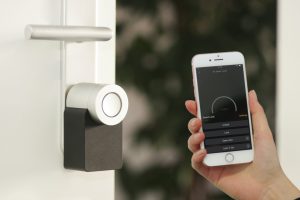Self-storage management software can offer several advantages for security and access control, this blog post is going to explain the key benefits.

Automated Access Control
Automated access control is a key feature of self-storage management software that can provide many benefits to both facility managers and tenants. Essentially, automated access control involves using software and hardware to manage and regulate access to a self-storage facility. With self-storage management software, tenants can be provided with access codes or access cards that allow them to enter the facility and access their storage unit. These codes or cards can be easily managed by the software, and can be revoked or changed if necessary. This can help to ensure that only authorised individuals are able to access the facility and its units. Automated access control can also provide a record of who has accessed the facility and when. This information can be used to monitor activity and identify any issues or irregularities. For example, if a tenant reports that their unit has been broken into, the software can be used to determine who accessed the facility around the time of the break-in, and to identify any potential suspects. In addition, automated access control can be used to regulate access to certain areas of the facility. For example, some self-storage facilities may have restricted areas where only staff members are allowed to go. With self-storage management software, these areas can be secured with additional access controls, such as keycard readers or biometric scanners, to ensure that only authorised staff members are able to enter. Overall, automated access control is a valuable feature of self-storage management software that can help to improve security and ensure that the facility operates safely and efficiently. By automating access control, self-storage facility managers can save time, reduce the risk of security breaches, and provide a better experience for tenants.Video Surveillance
Video surveillance is another important feature of self-storage management software that can help to improve security and provide peace of mind for both facility managers and tenants. Video surveillance involves using cameras to monitor activity within the facility, and can provide a record of any incidents or suspicious behaviour. With self-storage management software, video surveillance can be integrated into the system to provide a seamless and comprehensive security solution. The software can be used to manage the cameras, view footage, and set up alerts or notifications for certain events, such as motion detection or tampering with the cameras. One of the main benefits of video surveillance is its deterrence effect. Knowing that they are being watched can discourage potential thieves or vandals from attempting to break into the facility or damage property. In addition, in the event of an incident, the footage captured by the cameras can be used to identify suspects and provide evidence for law enforcement or insurance claims. Video surveillance can also be used to monitor activity within the facility to ensure that tenants are accessing their units appropriately and that there is no unauthorised access. This can help to prevent theft or damage to property, and ensure that the facility is operating safely and efficiently. Overall, video surveillance is an important component of self-storage management software that can help to improve security and provide valuable information in the event of an incident. By integrating video surveillance into their security systems, self-storage facility managers can provide a safer and more secure environment for their tenants, and ensure that their property is protected.Alarm Systems
Alarm systems are another important component of self-storage management software that can help to improve security and provide protection against unauthorised access. Alarm systems involve using sensors or detectors to detect and alert facility managers of any attempts to breach the security of the facility. With self-storage management software, alarm systems can be integrated into the system to provide a comprehensive security solution. The software can be used to manage the sensors or detectors, set up alerts or notifications for certain events, and notify facility managers or law enforcement in the event of an incident. There are several types of alarm systems that can be used in a self-storage facility, including: Intrusion Alarms: These types of alarms are triggered when someone attempts to enter the facility without authorisation. They can be triggered by sensors on doors or windows, or by motion detectors. Smoke Alarms: Smoke alarms can detect smoke or fire within the facility, and alert facility managers or tenants to evacuate the building. Water Alarms: Water alarms can detect leaks or flooding within the facility, and alert facility managers or tenants to take action to prevent damage to property. Temperature Alarms: Temperature alarms can detect extreme temperature changes within the facility, such as a malfunctioning HVAC system or a fire, and alert facility managers or tenants to take action. Alarm systems can provide several benefits for self-storage facilities. They can help to deter potential thieves or vandals, provide an additional layer of security to prevent unauthorised access, and ensure that facility managers are quickly alerted to any potential issues or incidents. Overall, integrating alarm systems into self-storage management software can help to provide a more secure and safe environment for tenants and their property.
Monitoring and Reporting
Monitoring and reporting are critical components of self-storage management software, storage software, self-storage software, and storage management platform that can help facility managers to monitor and track their facility’s performance, identify areas for improvement, and make informed business decisions. With monitoring and reporting features, self-storage management software, storage software, self-storage software, and storage management platform can track various aspects of the facility’s operation, such as occupancy rates, rental income, and tenant turnover. The software can also monitor security systems, such as video surveillance, access control, and alarm systems, to ensure that the facility is operating safely and securely. Reporting features within self-storage management software, storage software, self-storage software, and storage management platform can help facility managers to understand trends in their business and make data-driven decisions. Reports can provide insights into factors such as which unit sizes are in high demand, which tenants are delinquent on payments, and which security issues have occurred within the facility. This information can be used to adjust pricing, improve marketing strategies, and address security concerns. Additionally, self-storage management software, storage software, self-storage software, and storage management platform can help facility managers to track maintenance requests and ensure that issues are addressed promptly. The software can also help managers to monitor and manage their employees’ schedules and performance. Overall, monitoring and reporting features within self-storage management software, storage software, self-storage software, and storage management platform can provide valuable insights into a facility’s operation, help to identify opportunities for improvement, and allow managers to make informed decisions. By leveraging these features, self-storage facility managers can run their businesses more efficiently and effectively, and provide a better experience for their tenants.Improved Efficiency
Improved efficiency is one of the key benefits of using self-storage software, storage software, storage management software, and self-storage management platform. These software solutions can streamline many aspects of facility management, allowing managers to focus their time and energy on other critical tasks. For example, self-storage software can automate the rental process, including generating contracts, collecting payments, and tracking move-ins and move-outs. This can save managers time and effort that would otherwise be spent on paperwork and manual processes. Storage management software and self-storage management platform can also help to automate other tasks, such as tenant billing and invoicing, inventory management, and maintenance requests. By automating these processes, managers can reduce errors, save time, and ensure that all tasks are completed in a timely and consistent manner. In addition, self-storage software, storage software, storage management software, and self-storage management platform can provide managers with real-time insights into their facility’s performance. Reports can be generated to track occupancy rates, rental income, and tenant turnover, allowing managers to identify trends and make data-driven decisions. This can help to optimise pricing and marketing strategies, as well as identify areas for improvement in the facility’s operations. Overall, self-storage software, storage software, storage management software, and self-storage management platform can help facility managers to operate their facilities more efficiently and effectively. By automating tasks and providing real-time insights, these software solutions can improve the bottom line, increase tenant satisfaction, and make facility management easier and more streamlined.Discover how SiteLink can transform your storage operation
Book an online demo today and see for yourself how SiteLink makes it easy to manage your self storage facility to the highest standards. Simply fill in the form below to get started.
